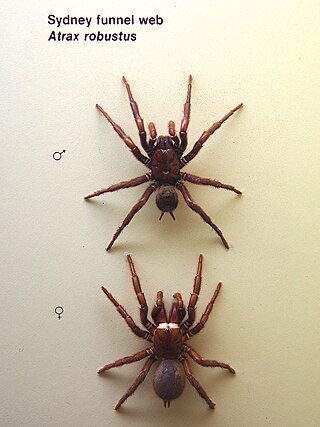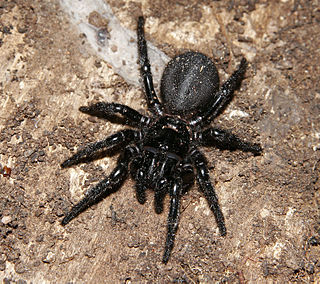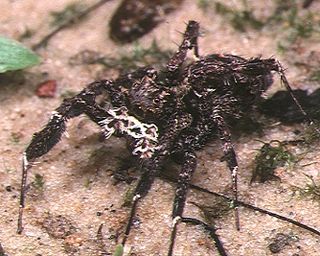
Atracidae is a family of mygalomorph spiders, commonly known as Australian funnel-web spiders or atracids. It has been included as a subfamily of the Hexathelidae, but is now recognised as a separate family. All members of the family are native to Australia. Atracidae consists of three genera: Atrax, Hadronyche, and Illawarra, comprising 35 species. Some members of the family produce venom that is dangerous to humans, and bites by spiders of six of the species have caused severe injuries to victims. The bites of the Sydney funnel-web spider and northern tree-dwelling funnel-web spider are potentially deadly, but no fatalities have occurred since the introduction of modern first-aid techniques and antivenom.

Hexathelidae is a family of mygalomorph spiders. It is one of a number of families and genera of spiders known as tunnelweb or funnel-web spiders. In 2018, the family was substantially reduced in size by genera being moved to three separate families: Atracidae, Macrothelidae and Porrhothelidae.

Austracantha is a genus of spider with a single species, Austracantha minax, commonly known as the jewel spider or the Christmas spider. It is a member of the family Araneidae and is endemic to Australia. They are relatively small spiders, reaching a maximum total body length of only around 12 mm (0.47 in) for females, and 5 mm (0.20 in) for males. Their abdomen has six distinctive projections ("spines") that makes them easy to identify. They are predominantly a shiny black, with variable white, yellow, and orange patterns. Melanistic forms also occur during autumn. They are facultatively gregarious, and can be found in large aggregations of overlapping orb webs. They feed on small flying insects that get entangled in their webs. They are harmless to humans, though the webs can be a nuisance for bushwalkers. They are most abundant during the summer months.

Hadronyche formidabilis, the northern tree-dwelling funnel-web spider, is a medically significant mygalomorph spider found in Queensland and New South Wales. It is also known as the Northern Rivers funnel-web spider or northern funnel-web spider.

The Sydney funnel-web spider is a species of venomous mygalomorph spider native to eastern Australia, usually found within a 100 km (62 mi) radius of Sydney. It is a member of a group of spiders known as Australian funnel-web spiders. Its bite is capable of causing serious illness or death in humans if left untreated.

Atrax is a genus of venomous Australian funnel web spiders that was first described by O. Pickard-Cambridge in 1877 from the type species Atrax robustus. As of May 2019 it contains only three species: A. robustus, A. sutherlandi, and A. yorkmainorum. Originally placed with the curtain web spiders, it was moved to the Hexathelidae in 1980, then to the Australian funnel-web spiders in 2018.

Hadronyche is a genus of venomous Australian funnel-web spiders that was first described by L. Koch in 1873. Originally placed with the curtain web spiders, it was moved to the Hexathelidae in 1980, then to the Atracidae in 2018.

Actinopodidae is a family of mygalomorph spiders found in mainland Australia and South America usually in open forest. Species are most common in Queensland, Australia. It includes mouse spiders, whose bites, though rare, are considered medically significant and potentially dangerous.

Missulena is a genus of mygalomorph spiders in the family Actinopodidae. It was first described by Charles Walckenaer in 1805, and is a senior synonym of Eriodon. M. tussulena is found in Chile, but the rest are indigenous to Australia. They are sometimes referred to as "mouse spiders" from the now-disproven belief that they dig deep burrows similar to those of mice. Scotophaeus blackwalli is also called a "mouse spider", but it is smaller and not closely related.

Maevia inclemens or the dimorphic jumping spider is a relatively common and colorful jumping spider of North America. In the males there are two forms, a very rare phenomenon in zoology. These use different courting displays, and differ in appearance: the "tufted" morph has a black body and pedipalps ("palps"), three black tufts across its "head", and pale legs; and the "gray" morph has black and white stripes all over its body and legs, orange palps, and no tufts. However, each form accounts for 50% of the adult males, and they are equally successful in mating. A female of Maevia inclemens is 6.5 to 8.0 millimetres long, while males are 4.75 to 6.50 millimetres long.

Agelena labyrinthica is a species of spider in the family Agelenidae. It is a widespread species in Europe and its range extends to Central and East Asia.

Portia fimbriata, sometimes called the fringed jumping spider, is a jumping spider found in Australia and Southeast Asia. Adult females have bodies 6.8 to 10.5 millimetres long, while those of adult males are 5.2 to 6.5 millimetres long. Both sexes have a generally dark brown carapace, reddish brown chelicerae ("fangs"), a brown underside, dark brown palps with white hairs, and dark brown abdomens with white spots on the upper side. Both sexes have fine, faint markings and soft fringes of hair, and the legs are spindly and fringed. However, specimens from New Guinea and Indonesia have orange-brown carapaces and yellowish abdomens. In all species of the genus Portia, the abdomen distends when the spider is well fed or producing eggs.

Missulena bradleyi, also known as the eastern mouse spider, is a species of spider belonging to the family Actinopodidae. The spider is endemic to the eastern coast of Australia.

Hadronyche infensa, the Darling Downs funnel-web spider, is a venomous mygalomorph spider, one of a number of Australian funnel-web spiders found in Queensland and New South Wales.

Hadronyche cerberea, the southern tree-dwelling funnel-web spider, is a venomous mygalomorph spider found in central New South Wales, Australia.

Hadronyche versuta, the Blue Mountains funnel-web spider, is a venomous mygalomorph spider found in central New South Wales.

Hadronyche modesta, the Victorian funnel-web spider, is a species of spider found in Victoria, Australia.
Atrax yorkmainorum is a venomous species of Australian funnel-web spider belonging to the Atracidae family and is found in forests in the vicinity of Canberra and south-eastern New South Wales. The genus Atrax was first documented in 1877 and the Atrax yorkmainorum species was first described in 2010.

Progradungula otwayensis, commonly known as the odd-clawed spider, is a species of cribellate spider endemic to the Great Otway National Park of Victoria, Australia. It is one of only two species in the gradungulid genus Progradungula.
Hadronyche macquariensis, the Port Macquarie funnel-web spider, is a venomous mygalomorph spider, one of a number of species of Australian funnel-web spiders] found in New South Wales.
















